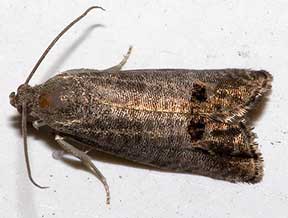 |
Previous Issues |
| Cedar Mill Community Website |
|
Search the Cedar Mill News: |
About The Cedar Mill News |
|
|||||||
| Volume 14, Issue 9 | September 2016 |
||||||
Caring for backyard fruit trees
|
||||
 |
One of the primary non-beneficial insects impacting apples, the Codling moth maybe more commonly known as the apple worm. Surprisingly small, the adult moth checks in at a whopping one-half inch. Depending on weather, there can be as many as three generations of moth per year. The Codling moth overwinters as full grown larvae enclosed in a cocoon under loose bark on the tree, in the ground, or in that pile of wood stacked near the tree. The cold-blooded insect responds to the warming environment in the spring and emerges as an adult moth ready to restart the cycle. Their arrival can be closely predicted by tracking Degree Days.
On the Cedar Mill News home page is a weather station that records daily temperatures. Oregon State has a website that provides models that can take the information provided by the Terra Linda weather station, or another closer to your location, and calculate the cumulative Degree Days, and will then project—based on historical averages—the future accumulation. Sounds technical, but it’s necessary information to determine the timing of cover sprays. There are Integrated Pest Management (IPM) approved sprays out there that can be used in an “organic” world if applied properly.
There is almost too much information on the internet about Codling moths, all interesting in their own right, but many of us have other things to do as well. Here’s a useful article from the Pacific Northwest Insect Management Handbook.
 |
In summary, what this article suggests is that if you have an apple tree in your back yard, be a good neighbor and take care of it. If you choose to control the Codling moth and other pests, enjoy the apples and share the abundance with neighbors. If you like the tree but don’t want the apples consider simply picking them early and disposing of them. For those in the latter category, there are sprays that will cause the apples to drop very early. If you don’t like the tree and don’t like the apples and don’t want to deal with the mess—strongly consider cutting it down. Apple makes a decent firewood.
Under any circumstances keep the area under the tree picked up. No rotten wormy apples, no small wood piles, and don’t use the cold compost pile over in the corner of the back yard for fallen apples. Someone’s pet chicken will be glad to scratch for over wintering larvae in the ground.
For those that want the apples and enjoy the tree and the bountiful harvest, perhaps more importantly for some of us grandparents watching the smile of grandchild picking and eating their own apple, some reasonable care, and near-absolute organic practices will provide usable fruit.
Perhaps try some reading about using Degree Days to time cover-spray applications. Carefully-timed means less spray in the environment. There are other devices like traps that can be used if you consider careful spraying undesirable. No control means wormy apples, No controls means you’re running a nursery for undesirable insects. The moths start flying on warm evenings, most often after dark, ignoring fence lines. They’re essentially invisible, but your neighbors will have a good idea who is harboring the undesirable insect.
[Ed. note: Chuck says he’s available to help folks figure out the right time to spray. Contact us and we’ll put you in touch.]
![]()
Like us on Facebook for timely updates
Published monthly by Pioneer Marketing & Design
Publisher/Editor:Virginia Bruce
info@cedarmillnews.com
PO Box 91061
Portland, Oregon 97291
© 2016